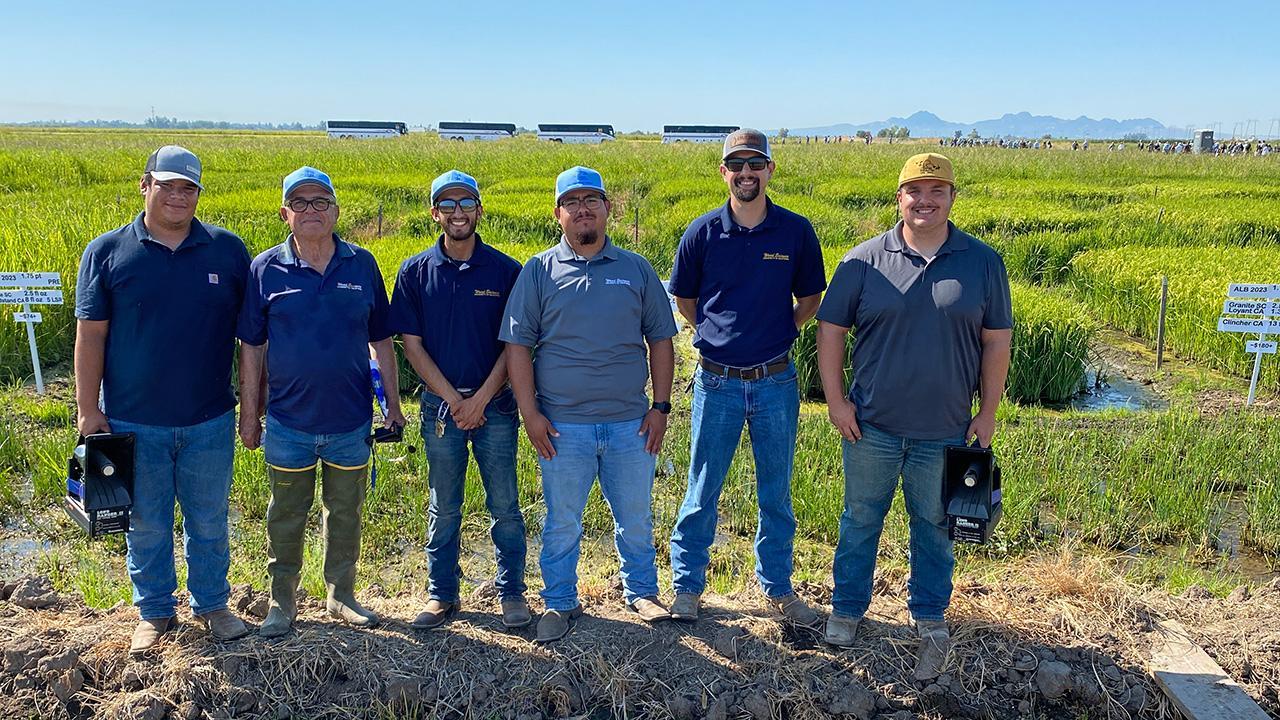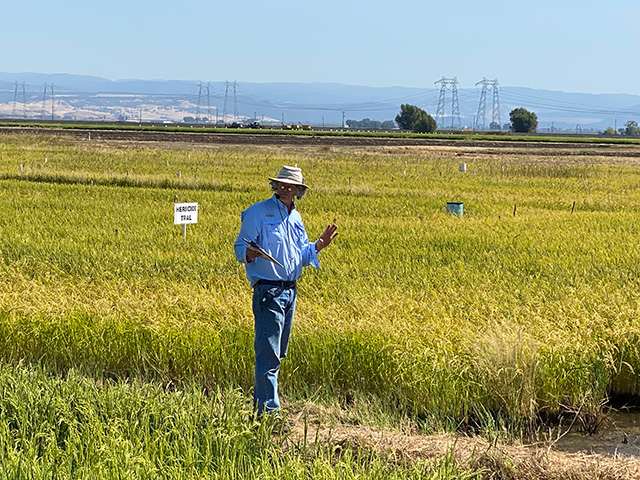Davis, California, USA
September 5, 2024
 Kassim Al-Khatib, second from left, is a professor in the UC Davis Department of Plant Sciences and expert in managing weeds in rice. During the recent Rice Field Day in Biggs, Calif., he presented research with team members, from left, Edgar O'Horan, Saul Estrada, Abel Bernal, Michael Lynch and Richard Pringle. (Trina Kleist/UC Davis)
Kassim Al-Khatib, second from left, is a professor in the UC Davis Department of Plant Sciences and expert in managing weeds in rice. During the recent Rice Field Day in Biggs, Calif., he presented research with team members, from left, Edgar O'Horan, Saul Estrada, Abel Bernal, Michael Lynch and Richard Pringle. (Trina Kleist/UC Davis)
Rice farmers in California this year are facing low prices for their crop, but record-high costs of production and hot temperatures during critical growth phases, Chairman Rob Doornbos of the California Cooperative Rice Research Foundation Inc. said at a recent event.
Researchers in the UC Davis Department of Plant Sciences offered some relief, describing trials of new herbicides and alternative cultivation methods during the Rice Field Day, held Aug. 28 at the Rice Experiment Station in Biggs, Calif.
New chemicals for weed management
To manage weeds, growers can use tillage and crop rotation, but herbicides continue to be an important tool, said Kassim Al-Khatib, the Melvin D. Androus Endowed Professor for Weed Science in the department. “But the problem is, we don’t have too many that we can use,” he added. “We have a severe problem with herbicide resistance.”
Al-Khatib and team are working with new chemicals that have unique modes of action to control resistant weds. They’re also experimenting with combinations of herbicides applied at different stages of plant growth and along a span of one to six weeks to get the best results with the least cost and damage to crops. Their goal is “to learn how to integrate these new tools into the water-seeded system and evaluate their efficacy,” the scientists wrote.
An especially promising new chemical is tetflupyrolinet, trademarked Dodhylex and created by FMC Corp. It’s being reviewed by the United States Environmental Protection Agency, so is not yet available for use. But in trials so far, Dodhylex is showing good control of grasses and no cross-resistance, Al-Khatib said.
“This is an herbicide that’s a game-changer,” Al-Khatib added. “The weed control is very impressive, and we’re getting good yield… Every indication is positive.”
Zembu is another valuabe product, based on the chemical pyraclonil. It is made by Nichino America Inc. and was released this year for the state’s rice growers. Researchers tested Zembu alone and in combination with Cliffhanger (made by Gowan Co.), Loyant (made by Corteva), and pendimethalin (sold under various trade names).
Al-Khatib recommended that growers experiment with different amounts of the herbicides, and following one herbicide with others throughout the growth period. He also urged growers to customize the sequence of chemicals they use, depending on what’s best suited for the weeds in their fields, while seeking to avoid crop injury.
Price, however, “is a problem,” Al-Khatib said. “Unfortunately, we don’t have anything that costs less than $100 an acre.”
 Scientists in the lab of Kassim Al-Khatib are experimenting with different combinations of herbicides to explore their effectiveness in preventing weeds in rice, while minimizing damage to the crop. They're also calculating costs per acre. (Trina Kleist/UC Davis)
Scientists in the lab of Kassim Al-Khatib are experimenting with different combinations of herbicides to explore their effectiveness in preventing weeds in rice, while minimizing damage to the crop. They're also calculating costs per acre. (Trina Kleist/UC Davis)
No-till cultivation good for fallowed land
Drought and the growing scarcity of water have forced as much as 100,000 acres of rice fields to lie fallow, more than double the rate a decade ago, said Bruce Linquist, a professor of Cooperative Extension in the department. That’s land that rice growers still could plant by using alternatives to the usual farming methods.
Linquist’s team is using techniques of conservation tillage, including no tilling at all, to test the impacts on yield. These systems all use drill-seeders -- equipment that cuts slots in dry soil to plant seeds -- rather than seeding fields that are flooded with a few inches of water.
That allows seed to be planted earlier, taking advantage of moisture remaining just a couple inches below the surface, Linquist said
The researchers focused on two approaches: planting into a field that had been fallowed the previous summer and the ground worked into a seedbed for the next planting; and strict, no-till systems on fields where rice had been grown the previous season, with no ground preparation between harvest and the next planting.
 Bruce Linquist, a professor of Cooperative Extension in the UC Davis Department of Plant Sciences, explains how low-till cultivation can enable rice growers to plant on fallowed land. He described the benefits and shortfalls during Rice Field Day in Biggs, Calif., on Aug. 28. (Trina Kleist/UC Davis)
Bruce Linquist, a professor of Cooperative Extension in the UC Davis Department of Plant Sciences, explains how low-till cultivation can enable rice growers to plant on fallowed land. He described the benefits and shortfalls during Rice Field Day in Biggs, Calif., on Aug. 28. (Trina Kleist/UC Davis)
In multi-year trials, scientists are finding a trade-off between water savings and yield. The systems used less water, saving as much as 20 percent of typical water usage in the growing season; that was due to less loss of water to evaporation. Aquatic weeds and tabpole shrimp were not a problem, but grasses and winter weeds could require attention, Linquist reported. However, no-till systems yielded about five to six sacks per acre less than conventional systems, he said.
Members of the Linquist team also are studying these alternative systems in relation to fertility, nutrient management, and the impacts on the greenhouse gases that rice field emit. Rice fields are “responsible for a significant proportion of agricultural greenhouse gas emissions, particularly methane,” wrote Zhenglin Zhang, a doctoral student working with Linquist.
More information
- For details on the herbicide trials, contact Al-Khatib here.
- For details on low-till and no-till alternatives, contact Linquist here.
- Related article: “No-till, direct-seeded rice saves 15% of water.”
- For more information and resources about rice cultivation, visit the UC Rice Research and Information Center here.
- Read more about the Rice Experiment Station here.